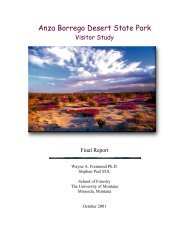Final Mitigated Negative Declaration and Response to Comments
Final Mitigated Negative Declaration and Response to Comments
Final Mitigated Negative Declaration and Response to Comments
Create successful ePaper yourself
Turn your PDF publications into a flip-book with our unique Google optimized e-Paper software.
<strong>and</strong> riparian corridor vegetation communities. The broad resource base enabled various kinds<br />
of subsistence activities practiced by ethnographic Washoe.<br />
HISTORICAL BACKGROUND<br />
Although the Washoe were largely excluded from Lake Tahoe his<strong>to</strong>ric era development, one<br />
element adopted was the name. Also known as “Mountain Lake,” “Lake Bonpl<strong>and</strong>,” <strong>and</strong> “Lake<br />
Bigler,” the name “Tahoe” was initially derived from the Washoe word da’ow, signifying “lake.”<br />
Lake Tahoe was not officially named by the California legislature until 1945 (Lindström 2000).<br />
When John C. Fremont traversed the Sierra Nevada for the purposes of conducting an<br />
expedition for the U.S. Bureau of Topographical Engineers, he came upon the deep blue<br />
mountain lake that would eventually become known as Lake Tahoe in the winter of 1844.<br />
Later the same year, six men from the Stephens-Townsend-Murphy emigrant party followed<br />
the Truckee River <strong>to</strong> its outlet in<strong>to</strong> Lake Tahoe. As such, they became the first known<br />
Euroamericans <strong>to</strong> set foot on the shores of the lake (Scott 1957). The lake remained<br />
undisturbed throughout the latter part of the decade as people rushed <strong>to</strong> the California gold<br />
fields, bypassing the lake <strong>to</strong> avoid dual summit crossings. The first Euroamerican trading post<br />
was not established in the Tahoe Basin until 1851 in Lake Valley.<br />
The discovery of silver near Virginia City caused a reverse migration from west <strong>to</strong> east with<br />
travel corridors becoming established through the Tahoe basin. The development of Nevada’s<br />
Coms<strong>to</strong>ck mines was only possible by exploiting the lake’s seemingly endless supply of timber<br />
<strong>and</strong> water needed <strong>to</strong> build the square-set timbering system <strong>and</strong> <strong>to</strong> supply water for the steampowered<br />
mills (Elliot 1973).<br />
The urgent dem<strong>and</strong> for fuel wood <strong>and</strong> construction lumber by the growing settlements <strong>and</strong><br />
mines devastated the forest st<strong>and</strong>s east of the Carson Range <strong>and</strong> the Lake Tahoe basin.<br />
Within the basin, timber was initially harvested along the east side of the lake followed by<br />
operations exp<strong>and</strong>ing <strong>to</strong> the west, north <strong>and</strong> south shores, respectively. Many his<strong>to</strong>rical<br />
records <strong>and</strong> pho<strong>to</strong>graphs (Scott 1957, 1973) indicate that many timber st<strong>and</strong>s were clear-cut.<br />
Clear-cutting on steep slopes <strong>and</strong> near drainages accelerated erosion <strong>and</strong> caused high<br />
sediment loads <strong>to</strong> enter the streams <strong>and</strong> subsequently in<strong>to</strong> the lake. The basin was stripped of<br />
marketable timber by 1898 which concluded large-scale harvesting operations in the area<br />
(Lindström 2000).<br />
With people traveling through the basin from the California Mother Lode <strong>to</strong> Nevada’s Coms<strong>to</strong>ck<br />
Lode, came the need for new travel routes through the basin. The most popular route was the<br />
road along Tahoe’s south shore which is the approximate alignment of modern Highway 50<br />
<strong>and</strong> Pioneer Trail (L<strong>and</strong>auer 1996). Various summit passes opened by the early 1860s but<br />
roads were generally in poor condition <strong>and</strong> did not yet circumvent the lake. Steamer traffic<br />
dominated travel in the Tahoe basin from the 1860s <strong>to</strong> 1910s. Au<strong>to</strong>mobile traffic increased<br />
through the basin with the designation of the Lincoln Highway, the nation’s first coast-<strong>to</strong>-coast<br />
highway, <strong>and</strong> included the main road through South Lake Tahoe (Highway 50/Pioneer Trail) as<br />
well as the road over Donner Summit (Highway 40/Interstate 80). The U.S. Bureau of Public<br />
Asian Clam Control Project IS/MND<br />
Emerald Bay State Park<br />
California Department of Parks <strong>and</strong> Recreation<br />
36
















